Other Mamiya 35mm Cameras
Mamiya also produced other 35mm cameras, most of which
fit into the category of "point-and-shoot" instruments. While many
of them were well-designed for the market in which they contended,
few of them are part of my collection, and I have very little information
available beyond what is listed here. The more data I can collect,
the more I can make available here, even if these particular cameras
never make it into my collection. If you have information to share,
please consider joining my
Collecting Mamiya 35mm Forum (it's free!) |
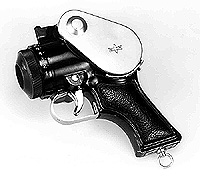
MAMIYA SPEED SHOT SPECIAL (c.1954) |
Mamiya Speed Shot Special
Also known as the Mamiya Pistol
Camera, this is one of the rarest Mamiya cameras. A specialty
camera (definitely not a point-and-shoot, no pun intended), only
250 are believed to have been made for police training purposes,
and it was never sold to the public. It had a single-speed shutter
(timing unknown) and fixed-focus 45mm Sekor f/5.6 lens, and produced
half frame images on 35mm film.
According to "McKeown's Guide to Antique & Classic Cameras" one
was sold at a Christie's auction in July 1993 for $16,500. |
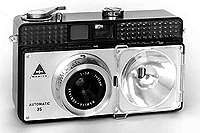
MAMIYA AUTOMATIC 35 EEF (c.1961)

Opening the film door of the
MAMIYA AUTOMATIC 35 EEF
|
Mamiya Automatic 35 EEF
Perhaps Mamiya's first attempt at the
35mm point-and-shoot market, the brick-like Mamiya Automatic 35
EEF featured a built-in flash for AG-1 bulbs, and automatic exposure
controlled by a selenium meter. It was also re-branded and sold in
the USA through Sears as both the Tower 39 (c.1961) and the
Tower 41 (c.1962). The Mamiya and Tower 39 versions had a 45mm
Mamiya-Tower Kominar zone-focusing f/3.8 lens. The Tower 41, in addition
to a faster f/2.8 lens, included an accessory shoe, rangefinder and
sync post.
Several readers, myself included, found it difficult to open the film
door of any version of this classic. Thanks to reader Dave Lewis,
in Manchester, England, for telling us it is accomplished by sliding
the back viewfinder bezel upward! |
.jpg)
MAMIYA (Argus) 260 AUTOMATIC (c.1964) |
Argus (Mamiya) 260 Automatic
Built by Mamiya for Argus (c.1964), the Argus
260 is basically their version of the Kodak Instamatic. The same size as an
Instamatic, it takes the same 126 film cartridge. It also utilizes flash-cube
technology, and has a flip-up flash bulb reflector similar to those found on
Kodak Motormatics. A manual-focus camera, it has the distance scale on top of
the front lens ring. It used PX825 mercury batteries (which are no longer
available). All indications are it was built only for export.
|
|
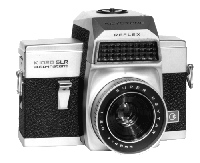
MAMIYA (Keystone) K1020 (c.1966)
|
Keystone (Mamiya) K1020
According to my information, Mamiya produced the Keystone
K1020, the world's first Instamatic single-lens-reflex camera,
in June 1966. It featured a 48mm Super Keytar f/2.8 lens, with a pentaprism
fresnel split-image finder. It had a selenium photo cell, and a graduated
light-meter needle that was visible on the left side of the finder. It used
Kodapack 126 film cartridges and had a flash cube socket on the top of
the prism housing.

|
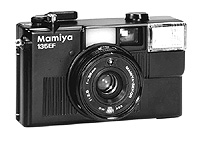
MAMIYA 135EF (c.1979) |
Mamiya 135EF
In December 1979, Mamiya introduced the plastic-bodied
Mamiya 135EF, its first direct venture back into the 35mm point-and-shoot
market since the Mamiya Automatic 35 EEF in 1961. A manual-focus camera
with 4-point zone markings for focus, it had a 38mm Mamiya-Sekor f/2.8
lens (4 elements in 3 groups), with a closest focus of 0.9 meters.
The finder included an underexposure warning, parallax correction
mark and flash-readiness indicator. It had only three shutter speeds
(1/25 - 1/60 - 1/250), but did include a built-in flash. Electronic
exposure was controlled by a CdS meter, and the camera had a manual
film advance.
|

MAMIYA 135AF (c.1980) |
Mamiya 135AF
Close on the heels of the Mamiya 135EF, Mamiya introduced
the Mamiya 135AF in May 1980. In a casing similar to the 135EF,
the AF had the same 38mm Mamiya-Sekor f/2.8 lens and built-in flash.
It was possible to set the electronic flash manually, to aid in fill-in
light situations. It had automatic focus capability, and a electronic
aperture controlled by a CdS meter. Its closest focus was 1.2 meters.
Available shutter speeds varied from 1/8 - 1/450, and its film advance
was manual. |
.jpg)
MAMIYA U (c.1981) |
Mamiya U
Matching the drive to ever smaller 35mm point-and-shoot
cameras, the Mamiya U was introduced in July 1981. At 220g
it was 90-100g lighter than the EF and AF. Using a 35mm Mamiya-Sekor
f/2.8 lens (5 elements in 4 groups), it had a 4-zone manual focus
(from 1.0 meter to infinity) and electronically-controlled shutter
speeds from 1/8 to 1/500. It also had a self-timer and a built-in
flash with a manual override. A sliding lever on the top closed the
lens cover and locked the shutter. A silver-finished model was introduced
in October 1981. |
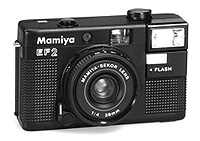
MAMIYA EF2 (c.1982)
|
Mamiya EF2
As a lower-priced entry, the Mamiya EF2 was
introduced in March 1982. Exposure settings were manual using three
weathermark positions. The CdS meter powered an under-exposure warning
in the finder. The EF2 was also a manual focus, with a 4-point zone
marking system. It used a relatively slow 38mm Mamiya-Sekor f/4.0
lens (3 elements in 3 groups) and had a built-in electronic flash,
which could also be set manually.
|

MAMIYA M (c.1982)
|
Mamiya M
The Mamiya M was first marketed in November
1982. It introduced the Seiko FCM autofocus system, with a focusing
range from one meter to infinity. Focus was automatically set by use
of a beam sensor. It was possible to lock focus by slightly depressing
the shutter button. The 38mm Mamiya-Sekor f/2.8 lens was electronically-controlled
by a CdS meter, and shutter speeds were from 1/8 - 1/500. It also
had auto film loading and film advance, and an electronic self-timer.
|
.jpg)
.jpg)
.jpg)
MAMIYA U AUTO FOCUS (c.1983),
was available
in three colors |
Mamiya U Auto Focus
The Mamiya U Auto Focus was introduced in July 1983.
It featured infrared automatic focusing and used a built-in CdS AE exposure
system, and had a film sensitivity from 50-1000 ASA/ISO. The lens was a 35mm
f/2, which focused from 0.9m to infinity, and the camera had an electronic
self-timer and automatic film advance. Shutter speeds varied from 1/8sec to
1/450sec, and it also featured an automatic built-in flash (Guide Number
12 - ASA/ISO 100). The lens could be protected by a manually sliding cover,
when not in use. It was sold in three colors: black, silver and red. |
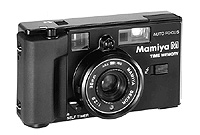
MAMIYA M TIME MEMORY (c.1983)
|
Mamiya M Time Memory
In November 1983, Mamiya upgraded the Mamiya M with
the introduction of the Mamiya M Time Memory. Essentially the
same camera as the Mamiya M, the Mamiya M Time Memory was fully automatic
in both focus and exposure, and used the same 38mm f/2.8 lens as the Mamiya M.
It also allowed for electronic self-timing and had the same manually-overidable
flash. It used a CdS meter and an electronic film advance. It also came with
an installed quartz dating mechanism, that allowed for automatic time & date
information to be added to the film.

|